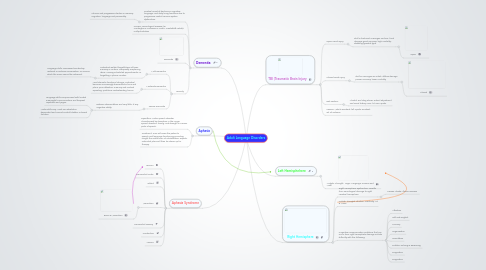
1. Aphasia Syndrome
1.1. Broca's
1.2. Transcortial motor
1.3. Global
1.4. Wernicke's
1.4.1. Broca & Wernicke's
1.5. Transcortial sensory
1.6. Conduction
1.7. Anomic
2. Aphasia
2.1. Dysarthria: Motor speech disorder characterized by disruption in the range, speed, direction, timing, and strength in various parts of speech.
2.2. Treatment: SLPs will asses the patient's speech and language functioning-providing insight the entire team of rehabilitation experts. Individual plans will then be drawn up for therapy.
3. Dementia
3.1. Gradual onset of declines in cognitive, language, and daily living functions due to progressive central nervous system dysfunction.
3.1.1. Chronic and progressive decline in memory, cognition, language and personality.
3.2. Causes: Neurological Disease (ex Huntington's, Parkinson's, Pick's, Creutzfeldt-Jakob), multiple strokes
3.3. Dementia
3.4. Severity
3.4.1. Mild Dementia
3.4.1.1. Individuals exhibit forgetfulness of basic memory or routine. Frequently misplacing items, missing scheduled appointments, or forgetting a phone number.
3.4.1.1.1. Language Skills: Decreased vocabulary, reduced or verbose conversation, or amonia which the name cannot be retrieved.
3.4.2. Moderate Dementia
3.4.2.1. Most dramatic functional change. Individual becomes increasingly disoriented in time and place, poor attention, memory and marked repeating, problems understanding humor.
3.4.3. Severe Dementia
3.4.3.1. Extreme disorientation and very little, if any, cognitive ability.
3.4.3.1.1. Language skills compromised with limited meaningful communication and frequent repetition and jargon.
3.4.3.1.2. Motor skills vary- most are wheelchair dependent and cannot control bladder or bowel function.
4. Left Hemisphehere
4.1. Analytic Thought, Logic, Language, Science and Math
5. TBI (Traumatic Brain Injury
5.1. Open Head Injury
5.1.1. skull is fractured, meninges are torn, focal damage good recovery, high mortality, stabbing/gunshot type
5.1.1.1. Open
5.2. Closed Head Injury
5.2.1. skull & meninges are intact, diffuse damage poorer recovery, lower mortality
5.2.1.1. Closed
5.3. Risk Factors:
5.3.1. Alcohol and drug abuse, school adjustment and social history, SES, h/o TBI, sports
5.4. Causes: Vehicle accident, fall, sports accident, act of violence
6. Right Hemisphere
6.1. Right Hemisphere Dysfunction: Results from neurological damage to right cerebral hemisphere.
6.1.1. Causes: Stroke, Illness, Disease
6.2. Holistic Thought, Intuition, Creativity, Art & Music
6.3. Cognitive-communication problems that can occur from right hemisphere damage include difficulty with the following:
6.3.1. Attention
6.3.2. Left side neglect
6.3.3. Memory
6.3.4. Organization
6.3.5. Orientation
6.3.6. Problem Solving & Reasoning
6.3.7. Pragmatics
6.3.8. Pragmatics
